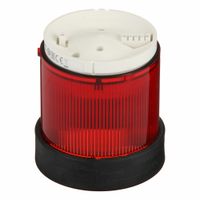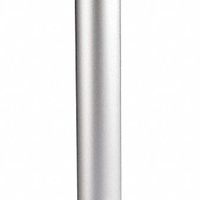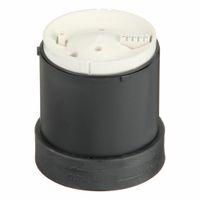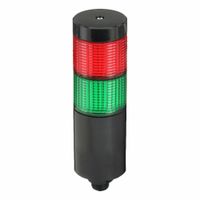Call +(254) 703 030 000 / 751 483 999 / 721 704 777
.....Read More
Frequently Asked Questions
What are tower lights used for?
Tower lights, also known as signal tower lights or stack lights, are used for visual and sometimes auditory signaling in various industrial and commercial settings. They serve several key purposes:
1. **Status Indication**: Tower lights provide a clear, visual indication of the operational status of machinery or processes. Different colors represent different states, such as green for normal operation, red for a fault or stop condition, yellow for a warning or caution, and blue or white for specific conditions like maintenance or setup.
2. **Process Monitoring**: In manufacturing and production environments, tower lights help operators and supervisors monitor the status of production lines or equipment from a distance. This allows for quick identification of issues, reducing downtime and improving efficiency.
3. **Safety Alerts**: Tower lights enhance workplace safety by alerting personnel to potential hazards or emergency situations. For example, a flashing red light might indicate an emergency stop or a critical fault that requires immediate attention.
4. **Communication**: In environments where noise levels are high, tower lights provide a non-verbal means of communication. They convey important information without relying on sound, which can be crucial in loud industrial settings.
5. **Remote Monitoring**: Some advanced tower lights are integrated with network systems, allowing for remote monitoring and control. This capability is useful in automated systems and smart factories, where real-time data is essential for decision-making.
6. **Auditory Signals**: Many tower lights are equipped with buzzers or alarms to provide auditory signals in addition to visual cues, ensuring that alerts are noticed even if the visual signal is missed.
Overall, tower lights are essential tools for enhancing operational efficiency, safety, and communication in various industries, including manufacturing, logistics, and automation.
How do tower lights communicate equipment status?
Tower lights, also known as signal tower lights or stack lights, communicate equipment status through a series of colored lights, each representing a different condition or status of the equipment. These lights are typically mounted on machinery or control panels and are visible from a distance, allowing operators and maintenance personnel to quickly assess the operational state of the equipment.
1. **Color Coding**:
- **Red**: Indicates a critical issue or emergency stop. It signals that the equipment is malfunctioning or requires immediate attention.
- **Yellow/Amber**: Represents a warning or caution. It suggests that the equipment is operating under suboptimal conditions or that a potential issue may arise.
- **Green**: Signifies normal operation. It means the equipment is functioning correctly and efficiently.
- **Blue**: Often used to indicate a request for service or assistance.
- **White/Clear**: Can denote a variety of conditions, such as equipment setup or standby mode.
2. **Flashing Patterns**:
- Steady or flashing lights can convey different meanings. For example, a flashing red light might indicate a more urgent problem than a steady red light.
3. **Audible Alarms**:
- Some tower lights are equipped with sound alarms to provide an additional layer of notification, especially in noisy environments.
4. **Integration with Control Systems**:
- Tower lights can be integrated with programmable logic controllers (PLCs) or other control systems to automatically update the status based on real-time data from the equipment.
5. **Remote Monitoring**:
- Advanced systems may allow for remote monitoring and control, providing status updates through networked systems or mobile devices.
By using these visual and auditory signals, tower lights effectively communicate the operational status of equipment, enabling quick response to issues and ensuring efficient workflow management.
What are the components of a modular tower light system?
A modular tower light system, often used in industrial settings for signaling and status indication, consists of several key components:
1. **Base Unit**: This is the foundation of the tower light system, providing stability and housing the electrical connections. It often includes a mounting bracket for installation on machinery or control panels.
2. **Light Modules**: These are the stackable sections of the tower, each containing a light source. They are available in various colors (red, green, yellow, blue, white) to convey different statuses or alerts. Each module can be equipped with different types of light sources, such as LED, incandescent, or xenon, depending on the application requirements.
3. **Sound Module**: An optional component that can be added to provide audible alerts. It can produce different sounds or tones to indicate various conditions, such as alarms or warnings.
4. **Connection Module**: This component facilitates the electrical connections between the light modules and the base unit. It ensures that each module receives the necessary power and signals to operate correctly.
5. **Control Unit**: This is the interface for configuring and controlling the tower light system. It can be integrated into the base or exist as a separate unit. The control unit allows for the customization of light sequences, sound patterns, and other operational parameters.
6. **Extension Tube**: Used to elevate the tower light for better visibility, especially in large or crowded environments. It can be of varying lengths to suit different installation needs.
7. **Dome or Cap**: The topmost part of the tower light, which protects the modules from dust, moisture, and other environmental factors. It also helps in diffusing the light for better visibility.
These components work together to create a flexible and customizable signaling solution for various industrial applications.
How do you install a tower light assembly?
1. **Safety First**: Ensure the power supply is turned off to prevent electrical shock. Wear appropriate personal protective equipment.
2. **Gather Tools and Materials**: You will need a screwdriver, wire strippers, a wrench, and the tower light assembly kit, which includes the base, light modules, and mounting hardware.
3. **Select Mounting Location**: Choose a location that is visible and accessible. Ensure the surface is stable and can support the weight of the tower light.
4. **Assemble the Tower Light**:
- Start with the base. Attach the light modules in the desired order, usually from bottom to top, by aligning the connectors and twisting them into place.
- Secure the modules with the locking ring or screws provided.
5. **Mount the Assembly**:
- Use the mounting hardware to attach the base to the chosen surface. This could involve drilling holes and using bolts or screws.
- Ensure the assembly is upright and securely fastened.
6. **Wiring**:
- Strip the ends of the wires from the power source and the tower light.
- Connect the wires according to the manufacturer's instructions, typically matching colors (e.g., red to red, black to black).
- Use wire nuts or terminal blocks to secure the connections.
7. **Test the Installation**:
- Turn the power back on.
- Test each light module to ensure they illuminate correctly and respond to control signals.
8. **Final Checks**:
- Ensure all connections are tight and secure.
- Verify that the tower light is stable and not wobbling.
9. **Documentation**: Record the installation details for future reference and maintenance.
What are the benefits of using wireless controllers for tower lights?
Wireless controllers for tower lights offer several benefits:
1. **Flexibility and Mobility**: Wireless controllers eliminate the need for extensive wiring, allowing for easy relocation and reconfiguration of tower lights without the constraints of physical connections.
2. **Cost-Effective Installation**: By reducing the need for complex wiring and cabling, wireless systems lower installation costs and time, making them a more economical choice for both new setups and retrofits.
3. **Scalability**: Wireless systems can be easily expanded to accommodate additional tower lights or other devices, providing a scalable solution that can grow with operational needs.
4. **Reduced Maintenance**: With fewer physical connections, there is less wear and tear, leading to reduced maintenance requirements and longer system lifespan.
5. **Remote Monitoring and Control**: Wireless controllers enable remote access to tower lights, allowing operators to monitor and control lighting systems from a distance, enhancing convenience and operational efficiency.
6. **Improved Safety**: By minimizing the need for manual intervention and reducing the risk of electrical hazards associated with wired systems, wireless controllers enhance workplace safety.
7. **Enhanced Reliability**: Modern wireless systems are designed to be robust and reliable, with features like signal redundancy and interference resistance, ensuring consistent performance.
8. **Energy Efficiency**: Wireless systems can be integrated with smart technologies to optimize energy use, such as dimming lights when not needed or adjusting brightness based on ambient conditions.
9. **Data Collection and Analysis**: Wireless controllers can facilitate data collection on light usage and performance, enabling better analysis and decision-making for maintenance and energy management.
10. **Environmental Benefits**: By reducing the need for extensive cabling and associated materials, wireless systems contribute to a smaller environmental footprint.
How can sounder modules enhance tower light systems?
Sounder modules can significantly enhance tower light systems by providing auditory signals in addition to visual cues, thereby improving communication and safety in various environments. These modules are particularly beneficial in noisy or visually cluttered settings where visual signals alone might be insufficient.
1. **Enhanced Communication**: Sounder modules add an auditory dimension to the alert system, ensuring that critical messages are conveyed even if the visual signals are missed. This dual-sensory approach can be crucial in environments where operators are not always in the line of sight of the tower lights.
2. **Increased Safety**: By providing audible alerts, sounder modules can quickly draw attention to urgent situations, such as equipment malfunctions or safety breaches, allowing for faster response times. This is particularly important in industrial settings where immediate action is required to prevent accidents.
3. **Customizable Alerts**: Sounder modules often allow for customizable tones and volumes, enabling the differentiation of alerts based on urgency or type of event. This customization helps in prioritizing responses and reducing confusion among personnel.
4. **Improved Accessibility**: For individuals with visual impairments, sounder modules ensure that they are still aware of alerts and can respond accordingly. This inclusivity is vital in ensuring that all personnel are informed and can act in emergency situations.
5. **Operational Efficiency**: By integrating sounder modules, tower light systems can reduce downtime and improve operational efficiency. Audible alerts can prompt quicker maintenance actions and minimize disruptions in workflow.
6. **Versatility**: Sounder modules can be used in various applications, from manufacturing plants to public spaces, enhancing the versatility of tower light systems. They can be programmed to suit specific operational needs, making them adaptable to different environments.
In summary, sounder modules enhance tower light systems by providing a comprehensive alert mechanism that improves safety, communication, and operational efficiency.
What are the best practices for maintaining tower lights?
1. **Regular Inspections**: Conduct routine inspections to identify any signs of wear, corrosion, or damage. Check for loose connections, broken lenses, and ensure all components are securely fastened.
2. **Cleaning**: Keep the lights and lenses clean from dirt, dust, and debris to ensure maximum visibility and performance. Use appropriate cleaning agents that do not damage the materials.
3. **Check Electrical Connections**: Regularly inspect and tighten electrical connections to prevent power loss or short circuits. Ensure that all wiring is intact and properly insulated.
4. **Replace Bulbs and LEDs**: Replace burnt-out bulbs or malfunctioning LEDs promptly. Use high-quality, weather-resistant bulbs designed for tower lights to ensure longevity and reliability.
5. **Test Functionality**: Periodically test the lights to ensure they are functioning correctly. This includes checking the light intensity, color, and any programmed flashing sequences.
6. **Weatherproofing**: Ensure that all components are adequately weatherproofed to withstand environmental conditions such as rain, snow, and extreme temperatures.
7. **Battery Maintenance**: For solar-powered or battery-backed systems, regularly check and maintain batteries. Replace them as needed to ensure consistent power supply.
8. **Documentation**: Keep detailed records of maintenance activities, inspections, and any repairs or replacements. This helps in tracking the performance and scheduling future maintenance.
9. **Compliance with Regulations**: Ensure that the tower lights comply with local and international aviation and safety regulations. This includes maintaining the correct light intensity, color, and placement.
10. **Training**: Ensure that maintenance personnel are adequately trained in handling and maintaining tower lights safely and effectively.
11. **Emergency Protocols**: Establish and maintain emergency protocols for quick response in case of light failure, especially for aviation safety-critical installations.




